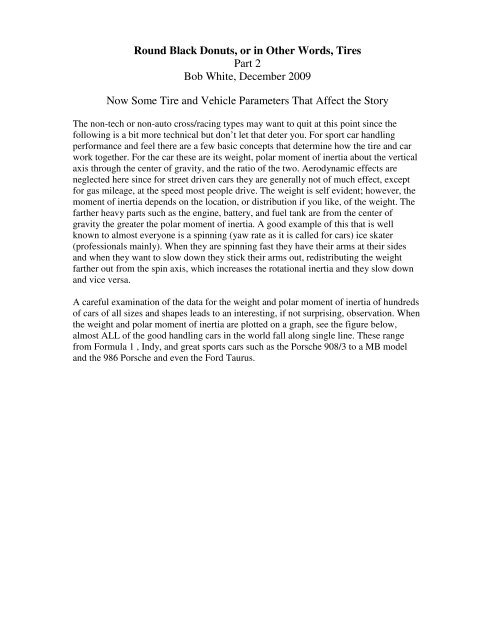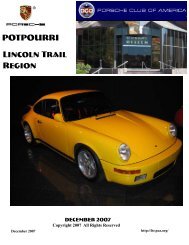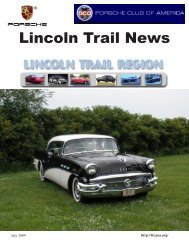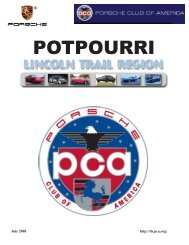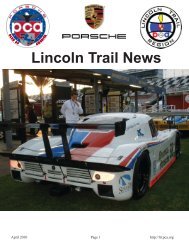Round Black Donuts, or in Other Words, Tires Part 2 Bob White ...
Round Black Donuts, or in Other Words, Tires Part 2 Bob White ...
Round Black Donuts, or in Other Words, Tires Part 2 Bob White ...
You also want an ePaper? Increase the reach of your titles
YUMPU automatically turns print PDFs into web optimized ePapers that Google loves.
<strong>Round</strong> <strong>Black</strong> <strong>Donuts</strong>, <strong>or</strong> <strong>in</strong> <strong>Other</strong> W<strong>or</strong>ds, <strong>Tires</strong><br />
<strong>Part</strong> 2<br />
<strong>Bob</strong> <strong>White</strong>, December 2009<br />
Now Some Tire and Vehicle Parameters That Affect the St<strong>or</strong>y<br />
The non-tech <strong>or</strong> non-auto cross/rac<strong>in</strong>g types may want to quit at this po<strong>in</strong>t s<strong>in</strong>ce the<br />
follow<strong>in</strong>g is a bit m<strong>or</strong>e technical but don’t let that deter you. F<strong>or</strong> sp<strong>or</strong>t car handl<strong>in</strong>g<br />
perf<strong>or</strong>mance and feel there are a few basic concepts that determ<strong>in</strong>e how the tire and car<br />
w<strong>or</strong>k together. F<strong>or</strong> the car these are its weight, polar moment of <strong>in</strong>ertia about the vertical<br />
axis through the center of gravity, and the ratio of the two. Aerodynamic effects are<br />
neglected here s<strong>in</strong>ce f<strong>or</strong> street driven cars they are generally not of much effect, except<br />
f<strong>or</strong> gas mileage, at the speed most people drive. The weight is self evident; however, the<br />
moment of <strong>in</strong>ertia depends on the location, <strong>or</strong> distribution if you like, of the weight. The<br />
farther heavy parts such as the eng<strong>in</strong>e, battery, and fuel tank are from the center of<br />
gravity the greater the polar moment of <strong>in</strong>ertia. A good example of this that is well<br />
known to almost everyone is a sp<strong>in</strong>n<strong>in</strong>g (yaw rate as it is called f<strong>or</strong> cars) ice skater<br />
(professionals ma<strong>in</strong>ly). When they are sp<strong>in</strong>n<strong>in</strong>g fast they have their arms at their sides<br />
and when they want to slow down they stick their arms out, redistribut<strong>in</strong>g the weight<br />
farther out from the sp<strong>in</strong> axis, which <strong>in</strong>creases the rotational <strong>in</strong>ertia and they slow down<br />
and vice versa.<br />
A careful exam<strong>in</strong>ation of the data f<strong>or</strong> the weight and polar moment of <strong>in</strong>ertia of hundreds<br />
of cars of all sizes and shapes leads to an <strong>in</strong>terest<strong>in</strong>g, if not surpris<strong>in</strong>g, observation. When<br />
the weight and polar moment of <strong>in</strong>ertia are plotted on a graph, see the figure below,<br />
almost ALL of the good handl<strong>in</strong>g cars <strong>in</strong> the w<strong>or</strong>ld fall along s<strong>in</strong>gle l<strong>in</strong>e. These range<br />
from F<strong>or</strong>mula 1 , Indy, and great sp<strong>or</strong>ts cars such as the P<strong>or</strong>sche 908/3 to a MB model<br />
and the 986 P<strong>or</strong>sche and even the F<strong>or</strong>d Taurus.
Figure. 2 Polar Moment of Inertia of selected cars.<br />
Data exists f<strong>or</strong> many m<strong>or</strong>e vehicles but they would be scattered all over the figure on<br />
either side of the dark l<strong>in</strong>e, mostly to the left, which passes through the po<strong>in</strong>ts f<strong>or</strong><br />
accepted good handl<strong>in</strong>g cars. To convert kg m^2 to lb ft^2 multiply by 23.67. To convert<br />
kg to lbm multiply by 2.2.<br />
Cars fall<strong>in</strong>g to the left of the dark l<strong>in</strong>e <strong>in</strong> figure no. 2 such as the Olds 98 have the “turn<br />
the steer<strong>in</strong>g wheel and wait f<strong>or</strong> someth<strong>in</strong>g to happen “ type of handl<strong>in</strong>g and those to the<br />
right have a “ jittery” type of feel<strong>in</strong>g and are easily affected by grooves <strong>in</strong> the road such<br />
as those <strong>in</strong> blacktop caused by heavy trucks. Mid eng<strong>in</strong>e cars tend to have the latter<br />
characteristic but manufacturers have learned to compensate f<strong>or</strong> this by mov<strong>in</strong>g certa<strong>in</strong><br />
heavy components such as batteries and radiat<strong>or</strong>s out to the c<strong>or</strong>ners to get the c<strong>or</strong>rect<br />
relationship, the Boxster be<strong>in</strong>g a good example. This does not mean that low polar<br />
moment of <strong>in</strong>ertia cars are bad handl<strong>in</strong>g. It means that it must also be associated with an<br />
appropriate weight as <strong>in</strong> figure no. 2. Cars with outstand<strong>in</strong>g response and handl<strong>in</strong>g such<br />
as <strong>in</strong> F1 and the P<strong>or</strong>sche 908/3 have low moments of <strong>in</strong>ertia but also low weight.<br />
Weight is the big fact<strong>or</strong> <strong>in</strong> acceleration and brak<strong>in</strong>g and the weight to polar moment of<br />
<strong>in</strong>ertia ratio f<strong>or</strong> handl<strong>in</strong>g and response accelerations. The tire at the road contact area<br />
determ<strong>in</strong>es the f<strong>or</strong>ces to accomplish these accelerations. This br<strong>in</strong>gs up the need to<br />
discuss specific tire properties. In the follow<strong>in</strong>g the emphasis will be on those that are the<br />
most imp<strong>or</strong>tant f<strong>or</strong> handl<strong>in</strong>g and feel.
Let’s start with friction. The coefficient of friction is def<strong>in</strong>ed as the ratio of the f<strong>or</strong>ce to<br />
pull <strong>or</strong> push someth<strong>in</strong>g along a surface to its weight. In equation f<strong>or</strong>m this is shown<br />
below.<br />
The coefficient of friction mu = (pull<strong>in</strong>g f<strong>or</strong>ce) / weight<br />
The coefficient of friction f<strong>or</strong> rubber and a tire is a function of almost everyth<strong>in</strong>g i.e. mu<br />
is a function of load, area, temperature, tire pressure, speed, slid<strong>in</strong>g speed, road surface,<br />
contam<strong>in</strong>ants and lubrication, tire construction, the rubber composition and a few m<strong>or</strong>e.<br />
The numerical value of mu varies from almost zero (0.02 wet ice and hydroplan<strong>in</strong>g) to<br />
numbers like 3.0 f<strong>or</strong> a p<strong>in</strong>k pearl eraser be<strong>in</strong>g pulled along a sheet of glass. Without<br />
go<strong>in</strong>g <strong>in</strong>to details, hydroplan<strong>in</strong>g is a serious event where the tire rides up on a layer of<br />
water result<strong>in</strong>g <strong>in</strong> complete loss of control. We won’t talk about it further, but you should<br />
know that the speed at which hydroplan<strong>in</strong>g occurs (there are NASA rep<strong>or</strong>ts document<strong>in</strong>g<br />
the phenomena and I can supply them f<strong>or</strong> those who wish to know m<strong>or</strong>e) is given by<br />
Hydroplan<strong>in</strong>g speed <strong>in</strong> mph = 10.35 x square root (tire pressure <strong>in</strong> psi).<br />
Thus, if the tire pressure is 36 psi the hydroplan<strong>in</strong>g speed is = 10.35 x sqrt(36) = 10.35 x<br />
6 = 62 mph. This is basically <strong>in</strong>dependent of the tread which basically determ<strong>in</strong>es the<br />
depth of water <strong>in</strong> which hydroplan<strong>in</strong>g occurs but not the speed.<br />
Typical maximum coefficient of friction values f<strong>or</strong> some common types of tires can<br />
usually be well c<strong>or</strong>related by a l<strong>in</strong>ear function such that, mu = mu at zero load - C1 *<br />
(load <strong>in</strong> pounds). Figures no. 3 and 4 show the maximum coefficient of friction f<strong>or</strong> some<br />
street and race type tires respectively.<br />
Figure no. 3 Maximum Coefficient of Friction vs Load f<strong>or</strong> Some Street <strong>Tires</strong>
Figure no. 4 Maximum Coefficient of Friction vs Load f<strong>or</strong> Some Race <strong>Tires</strong><br />
The follow<strong>in</strong>g table is a key to the race tire legend <strong>in</strong> Figure no. 4.<br />
Table no. 1 Race Tire legend key<br />
Letter Tire Type and Size<br />
A 165 HR 15 (5 ½ J x 15)
B 245/575 – 15 slick (12 K x 15)<br />
C 265/575 – 15 slick (12 K x 15)<br />
D 215/60 VR XWX (7 J x 15)<br />
E 245/575 – 15 <strong>in</strong>termediate (12 K x 15)<br />
F 340/575 – 15 slick (15 K x 15)<br />
Notice <strong>in</strong> compar<strong>in</strong>g the friction values <strong>in</strong> Figures 3 and 4 that it is imp<strong>or</strong>tant to use the<br />
same load values s<strong>in</strong>ce the weight scales are different. F<strong>or</strong> the w<strong>or</strong>st race type tires the<br />
friction values are 20% <strong>or</strong> so higher than the best street values and the best race tire<br />
values are 60% <strong>or</strong> m<strong>or</strong>e better than the street values! F<strong>or</strong> the same radius of a turn the<br />
speed <strong>in</strong>creases with the square root of the mu value which means sqrt(1.6) = 1.26 <strong>or</strong> a<br />
26% <strong>in</strong>crease <strong>in</strong> speed, i.e. a 50 mph maximum turn speed becomes 60 mph with race<br />
tires.<br />
F<strong>or</strong> straight l<strong>in</strong>e acceleration <strong>or</strong> brak<strong>in</strong>g the change is directly prop<strong>or</strong>tional to the friction<br />
value assum<strong>in</strong>g the eng<strong>in</strong>e has sufficient t<strong>or</strong>que (and c<strong>or</strong>rect gear<strong>in</strong>g) to keep the tire at<br />
its maximum friction value. This leads to another characteristic of tires, there must be<br />
some slip between the tire and the road to produce any brak<strong>in</strong>g, acceleration, <strong>or</strong> turn<strong>in</strong>g<br />
f<strong>or</strong>ce. F<strong>or</strong> brak<strong>in</strong>g and acceleration the slip is ratio of the actual rotation speed of the tire<br />
and the ideal rotational speed be<strong>in</strong>g the rotation speed if you let the tire roll down a hill<br />
by itself. We will return to what slip is f<strong>or</strong> a c<strong>or</strong>ner<strong>in</strong>g tire a bit later. Thus, a free roll<strong>in</strong>g<br />
tire has a slip of zero and a locked up tire has 100% slip. Figure no. 5 below shows how<br />
the friction varies with slip.
Figure no. 5 The Relationship Between Tire Slip at the Road Interface and Coefficient of<br />
Friction. Note the mu max = 1.0 is used here is arbitrary to show the typical relation to<br />
slip but may be much larger as seen <strong>in</strong> Fig. no. 3 and 4<br />
Note how the coefficient of friction has a maximum at around 20% slip except f<strong>or</strong> new<br />
snow. The same is true of sand as on a beach, where the plow<strong>in</strong>g up of the snow <strong>or</strong> sand<br />
<strong>in</strong> front of the tire leads to an <strong>in</strong>crease <strong>in</strong> resistance. On n<strong>or</strong>mal road surfaces if the brakes<br />
are applied hard enough to generate slip greater than the maximum, the coefficient of<br />
friction drops and the tire sp<strong>in</strong>s down to 100% slip <strong>or</strong> locked up tire. At that po<strong>in</strong>t the tire<br />
has about 25% less stopp<strong>in</strong>g capability. This is why people are taught to pump the brakes<br />
to try to stay at <strong>or</strong> near the peak coefficient of friction. ABS systems do the this by<br />
chang<strong>in</strong>g brake l<strong>in</strong>e pressure to keep the friction at its peak. The ABS software knows on<br />
which side of the peak the tire slip is, s<strong>in</strong>ce the brak<strong>in</strong>g effect decreases as speed<br />
decreases if the slip is too low and the tire starts to sp<strong>in</strong> down if it is too high.<br />
Under acceleration and brak<strong>in</strong>g a sensitive driver can tell if the tire is past its maximum<br />
friction po<strong>in</strong>t s<strong>in</strong>ce at the maximum all of the friction is be<strong>in</strong>g used f<strong>or</strong> traction, so none is<br />
left to control side f<strong>or</strong>ces act<strong>in</strong>g on the car and the car beg<strong>in</strong>s to move around sideways.<br />
F<strong>or</strong> rear drive cars dur<strong>in</strong>g acceleration, this was sometimes referred to as fish tail<strong>in</strong>g. If<br />
you don’t believe the latter it is easy to demonstrate now that w<strong>in</strong>ter is here. Just step too<br />
hard on the gas on the ice and snow and note how the rear end immediately beg<strong>in</strong>s to<br />
slide sideways. F<strong>or</strong> front wheel drive cars if you step on the gas <strong>in</strong> a turn the car just goes<br />
straight.<br />
Now let’s return to the c<strong>or</strong>ner<strong>in</strong>g friction problem referred to earlier. The question <strong>in</strong> this<br />
case is what is meant by slip. F<strong>or</strong> c<strong>or</strong>ner<strong>in</strong>g, the def<strong>in</strong>ition is the difference <strong>in</strong> degrees<br />
between the direction the tire is po<strong>in</strong>t<strong>in</strong>g and the actual direction it is mov<strong>in</strong>g. Most<br />
drivers have experienced this, f<strong>or</strong> example, when driv<strong>in</strong>g on a slippery surface. If the<br />
steer<strong>in</strong>g wheel is turned too quickly the car only slowly beg<strong>in</strong>s to turn despite the fact that<br />
the tire is at a significant angle to the car’s direction. The difference <strong>in</strong> angle is called,<br />
rather imag<strong>in</strong>atively, the slip angle. The c<strong>or</strong>ner<strong>in</strong>g f<strong>or</strong>ce generated is usually measured<br />
by plac<strong>in</strong>g the tire on a rotat<strong>in</strong>g drum <strong>or</strong> convey<strong>or</strong>-like flat mov<strong>in</strong>g surface and measur<strong>in</strong>g<br />
the side f<strong>or</strong>ce exerted on the rim as the angle of the tire to the direction of motion is<br />
changed. Figure no. 6 below shows the value of side f<strong>or</strong>ce as a function of slip angle f<strong>or</strong><br />
six different race tires at three different tire loads.
Figure no. 6 Tire C<strong>or</strong>ner<strong>in</strong>g Side F<strong>or</strong>ce as a Function of Slip Angle f<strong>or</strong> Some Race <strong>Tires</strong><br />
Street tires exhibit the same characteristics except with lower maximum values, a smaller<br />
rate of <strong>in</strong>crease from zero slip, and about twice as large of a slip angle at the maximum<br />
value. The maximum value compared to the tire load determ<strong>in</strong>es the maximum mu value,<br />
see figures no. 3 and 4.<br />
The rate of <strong>in</strong>crease (<strong>or</strong> slope) of the c<strong>or</strong>ner<strong>in</strong>g f<strong>or</strong>ce from zero slip is essentially the side<br />
f<strong>or</strong>ce at a slip angle of 1 degree and is called the c<strong>or</strong>ner<strong>in</strong>g f<strong>or</strong>ce coefficient Cf. Figures<br />
no. 7 and 8 show values of the c<strong>or</strong>ner<strong>in</strong>g f<strong>or</strong>ce coefficient f<strong>or</strong> typical street tires and the<br />
race tires of Figure no. 6 respectively.
Figure no. 7 Typical C<strong>or</strong>ner<strong>in</strong>g F<strong>or</strong>ce Coefficients Cf f<strong>or</strong> Street <strong>Tires</strong>
Figure no. 8 C<strong>or</strong>ner<strong>in</strong>g F<strong>or</strong>ce Coefficients Cf f<strong>or</strong> the Race <strong>Tires</strong> of Figure no. 6 and it’s<br />
Legend.<br />
Notice that the c<strong>or</strong>ner<strong>in</strong>g f<strong>or</strong>ce coefficients of the race tires are substantially larger than<br />
f<strong>or</strong> street tires and <strong>in</strong> many cases are almost twice that of everyth<strong>in</strong>g but the P7 which<br />
was the first of the so called street super tires.<br />
Even good street tires seldom exceed 350 lbf./deg, while the larger, wider race tires can<br />
easily be <strong>in</strong> the 500 to 700 lbf/deg. range. Also keep <strong>in</strong> m<strong>in</strong>d that the load on the tire<br />
when turn<strong>in</strong>g is not the static load but the static load plus <strong>or</strong> m<strong>in</strong>us the weight transfer.<br />
F<strong>or</strong> a C<strong>or</strong>vette <strong>in</strong> a 1 gee turn the total weight transfer is about 1150 pounds which is<br />
distributed between the front and rear axles approximately <strong>in</strong> prop<strong>or</strong>tion to the front to<br />
rear weight distribution depend<strong>in</strong>g on the shock abs<strong>or</strong>bers, spr<strong>in</strong>gs, and anti-roll bars. To<br />
be m<strong>or</strong>e exact it is acc<strong>or</strong>d<strong>in</strong>g to the front and rear axle roll resistance values.<br />
Know<strong>in</strong>g the c<strong>or</strong>ner<strong>in</strong>g f<strong>or</strong>ce <strong>in</strong>f<strong>or</strong>mation, it is now possible to determ<strong>in</strong>e the basic level<br />
of vehicle steer<strong>in</strong>g response. Figure no. 9 def<strong>in</strong>es a few basic vehicle parameters that are<br />
needed to understand a cars response.
Figure no. 9 Some Vehicle Def<strong>in</strong>itions<br />
With these def<strong>in</strong>itions, it is possible to determ<strong>in</strong>e how a car turns and what its <strong>in</strong>itial<br />
response will be to a steer<strong>in</strong>g <strong>in</strong>put. So let’s look at figure no. 10. It also <strong>in</strong>cludes the<br />
def<strong>in</strong>ition of the lateral velocity acceleration and yaw velocity acceleration.
Figure no. 10 Def<strong>in</strong>ition of how a Car Turns and it’s Accelerations on Steer<strong>in</strong>g Input<br />
From the def<strong>in</strong>itions above f<strong>or</strong> the accelerations generated, the v and r with the dots<br />
above them <strong>in</strong> Figure no. 10, on <strong>in</strong>itial steer<strong>in</strong>g wheel <strong>in</strong>put a total of five fact<strong>or</strong>s<br />
determ<strong>in</strong>e the rate at which the vehicle responds. <strong>Other</strong> than the steer<strong>in</strong>g <strong>in</strong>put there is<br />
only one parameter that the owner can control without serious race car type<br />
modifications. That is the front tire c<strong>or</strong>ner<strong>in</strong>g f<strong>or</strong>ce coefficient by his <strong>or</strong> her choice of the<br />
tires. The car mass i.e. weight, polar moment of <strong>in</strong>ertia, and distance between the center
of gravity and front axle are determ<strong>in</strong>ed dur<strong>in</strong>g manufacture. Thus, an auto-x/super tire<br />
set with front tires hav<strong>in</strong>g 375 lbf/deg of c<strong>or</strong>ner<strong>in</strong>g f<strong>or</strong>ce compared to just a good tire<br />
with 275 lbf./deg. results <strong>in</strong> about a 36% <strong>in</strong>crease <strong>in</strong> the rate of vehicle <strong>in</strong>itial response.<br />
This article is about tires and how they come to be selected f<strong>or</strong> your car. However, how<br />
the tires effect the vehicles response and feel also depends on the properties of those<br />
tires.That is why the driv<strong>in</strong>g tests by both the tire and car manufacturer are so imp<strong>or</strong>tant<br />
to the feel that are associated with P<strong>or</strong>sche <strong>or</strong> C<strong>or</strong>vette <strong>or</strong> Mercedes-Benz and Lexus. So<br />
lets hear it f<strong>or</strong> the eng<strong>in</strong>eers, expert drivers, and their companies that understand the<br />
imp<strong>or</strong>tance of that feel to their customers.<br />
A f<strong>in</strong>al note on a related but some what different aspect of tires. Earlier it was po<strong>in</strong>ted<br />
out that the average car owner only has a flat tire on average every 60,000 miles. In some<br />
countries, Germany f<strong>or</strong> example, a tire may not be repaired, no plugs f<strong>or</strong> a nail <strong>in</strong> a tire.<br />
The tire must be replaced regardless of whether it has been driven 10 <strong>or</strong> 100 <strong>or</strong> 10,000<br />
miles. The figure below is a photograph of the <strong>in</strong>side of a tire that has had a nail hole<br />
repaired with a plug. There is an almost one <strong>in</strong>ch high by one quarter <strong>in</strong>ch <strong>in</strong> diameter<br />
piece of the rubbery filament used f<strong>or</strong> the plug stick<strong>in</strong>g out of the carcass of the tire.<br />
Figure no. 11 An Inside view of a Plugged Tire<br />
It is about as resilient as a piece of hot dog although stronger. So when you are driv<strong>in</strong>g it<br />
is bent by the centrifugal f<strong>or</strong>ce and flops around every time the brakes are applied,<br />
steer<strong>in</strong>g <strong>in</strong>puts change the car’s direction <strong>or</strong> bumps <strong>or</strong> tar strips flex the tire. Th<strong>in</strong>k about<br />
that the ext time you are go<strong>in</strong>g over the speed limit with a tire on your car that has a plug
<strong>in</strong> it. Seems like the Germans may have it right, especially with many parts of the<br />
autobahn still without speed limits.


